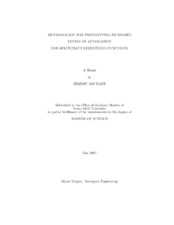| dc.description.abstract | The Crew Exploration Vehicle (CEV) necessitates higher levels of automation
than previous NASA vehicles due to program requirements for automation, including
Automated Rendezvous and Docking (AR&D). Studies of spacecraft development
often point to the locus of decision-making authority between humans and computers
(i.e. automation) as a prime driver for cost, safety, and mission success. Therefore,
a critical component in the CEV development is the determination of the correct
level of automation. To identify the appropriate levels of automation and autonomy
to design into a human space flight vehicle, NASA has created the Function-specific
Level of Autonomy and Automation Tool (FLOAAT).
This research develops a methodology for prototyping increased levels of automation
for spacecraft rendezvous functions. This methodology was used to evaluate the
accuracy of the FLOAAT-specified levels of automation, via prototyping. Two spacecraft
rendezvous planning tasks were selected and then prototyped in Matlab using
Fuzzy Logic (FL) techniques and existing Shuttle rendezvous trajectory algorithms.
The prototyped functions are the determination of the maximum allowable Timeof-
IGnition (TIG) slip for a rendezvous phasing burn and the evaluation of vehicle
position relative to Transition initiation (Ti) position constraints.
The methodology for prototyping rendezvous functions at higher levels of automation
is judged to be a promising technique. The results of the prototype indicate
that the FLOAAT recommended level of automation is reasonably accurate and that FL can be effectively used to model human decision-making used in spacecraft rendezvous.
FL has many desirable attributes for modeling human decision-making,
which makes it an excellent candidate for additional spaceflight automation applications.
These conclusions are described in detail as well as recommendations for future
improvements to the FLOAAT method and prototyped rendezvous functions. | en |


